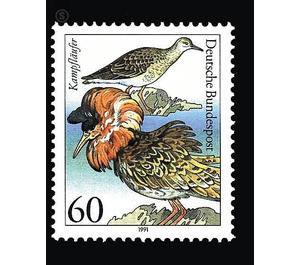Animal welfare - Threatened seabirds - Germany / Federal Republic of Germany 1991 - 60 Pfennig
Theme: Animals
| Country | Germany / Federal Republic of Germany |
| Issue Date | 1991 |
| Face Value | 60.00 |
| Color | multi-colored |
| Perforation | K 13 3/4: 14 |
| Printing Type | 4-color offset printing |
| Stamp Type | Postage stamp |
| Item Type | Stamp |
| Chronological Issue Number | 1412 |
| Chronological Chapter | GER-BRD |
| SID | 998684 |
| In 46 Wishlists | |
This snipe bird is characterized by a striking sexual dimorphism: the males, which are also significantly larger than the females (total length of males 300, females 230 mm), put on a splendor dress (wedding dress) with very differently colored neck ruffs (on the Vogel brand in the foreground ). No male is like another, which gives a high degree of individuality; because collar and ear tufts vary in color (white, rust red, chestnut brown, black) as in the pattern (monochrome, bright hems, wave drawings). The females look all year round simply sand-brownish (bird in the background). In the spring, the males meet in their typical habitats (lowland meadows, bogs and swamps, tundra) on short-grassed common courts and attract by their striking fighting - there are intense shameful fights without injury consequences for dominance in the arena held - the females. After mating, the female is completely on her own, turns first between tall grasses and herbs, then hides the nest well padded with some stalks, lays 4 eggs, broods them (incubation period 20 to 21 days) and guides the young (nest breeders), who are self-employed after 4 weeks. From the end of July until November at the latest, the ruffians will move to the African winter quarters, returning there from late February to early May. The ruff is still breeding bird in Germany, but only in a few places, mostly in the coastal area and on sturdy islands (bird protection islands). It was once widespread, found everywhere in wetlands, but has lost most of its nesting habitat, especially inland, through profound remodeling of the landscape. On the other hand, at the time of the migration it can often be observed on mudflats and sandbanks on the coasts and on inland foraging. These are High-Nornic stragglers.


